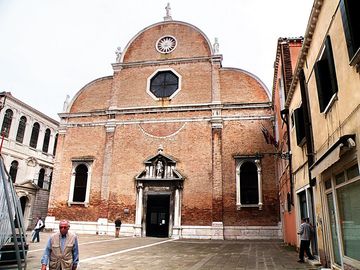

The Church of St Mary of the Carmelites, also known simply as the Carmini, was built in the 14th century and was originally known as the Church of St Mary of the Assumption. The facade was reconstructed in the 16th century. On the cusp of the 17th century belfry rises the statue of the Virgin, which was sculpted by Romano Vio in 1982, substituting the original one destroyed by lightening. The monks in the monastery wore the black scapulars - the monastic cloaks - that were sewn by the members of the neighboring Confraternity of Carmelites.
The triple-nave interior of the church is a unique example of Renaissance architecture. The two side aisles appear in the form of arcades with the columns supporting walls that jut out towards the central nave. On these walls hang 24 large paintings executed between the middle of 17th and 18th century by various artists such as Gianantonio Pellegrini and Gaspare Diziani. Other notable works include the Adoration of the Shepherds by Cima da Conegliano above the second altar, the Glorification of the Scapular fresco on the ceiling by Sebastiano Ricci, the Presentation of Jesus to the Temple altarpiece by Jacopo Tintoretto, located by the entrance to the sacristy, and the painting for the first altar by Lorenzo Lotto, Saint Nicholas of Bari in Glory between St John the Baptist and St Lucy.
The Carmelite religious order was founded in the 12th century in Israel on Mount Carmel. St Bertold is traditionally considered to be the founder, although few records exist to corroborate this theory. Bertold was a French crusader who established a hermit colony on the mount after experiencing a vision of Christ telling him to fight the evil of this world. The Carmelites are known for their strong charism, which means spiritual focus. Contemplation for them, however, implies not only prayer or mental concentration. It also includes community service. The Carmelites are protected by the Virgin Mary and are divided into three orders: the friars, who are active and contemplative; the nuns, who are cloistered; and the laypeople who marry and live in the world but participate in the charism with liturgical prayer and the propagation of the Christian message.